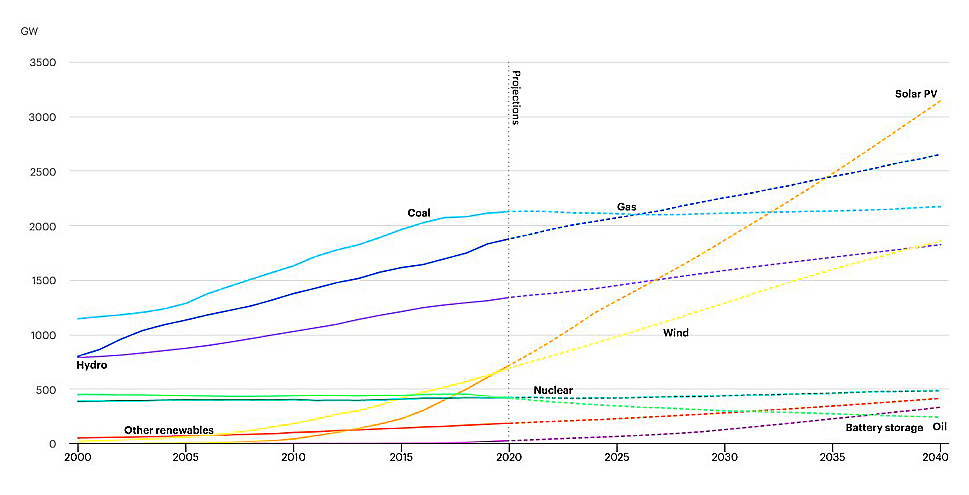Sustainable Governance
永續治理
Risks and Opportunities Posed by Changes in Global Energy Structure
Climate change has become the biggest threat to global sustainable development, which not only causes natural disasters, such as rainstorm, landslide, conflagration and hurricane but significantly affects the environment. Impacts like the change in temperature, humidity and rainfall would cause the spreading of infectious diseases. In response, many countries around the world have committed to the goal of achieving net-zero emission for greenhouse gas by 2050 in order to lift the global climate emergency. According to the Paris Agreement, the key to limiting the rise of global temperatures largely hinges on energy decarbonisation. The historic 2015 climate deal, endorsed nearly worldwide, calls for keeping the rise in average global temperatures “well below” two degrees Celsius (2°C) during the present century, compared to pre-industrial levels. The International Renewable Energy Agency (IRENA) report published in April, 2019 showed a roadmap of global energy transformation to net zero by 2050. It examines technology pathways and policy implications to ensure a sustainable energy future. Ramping up electricity to over half of the global energy mix (up from 20%) in combination with renewables would reduce the use of fossil fuels, and could lower greenhouse gas emission effectively. Based on the forecast scenario of this report, there are two different scenarios. The first is the “Reference Case,” where the greenhouse effect will raise average temperatures by 2.6°C to 3.0°C by 2050, and the cumulative greenhouse gas emission will increase to 1,230 billion tones, which fails to control the rise in average global temperatures well below 2.0°C. The second is the “Renewable Energy Roadmap Case,” where there is a 66% chance of reaching the rise in average global temperatures well below 2.0°C, and the cumulative greenhouse gas emission are reduced by 470 billion tones compared with that of the “Reference Case.” This indicates the goal of keeping the rise in global average temperature well below 2.0°C is technically feasible. Additionally, the IEA special report published on 18 May 2021 announced a global roadmap to net zero by 2050. This includes no investment in new fossil fuel supply projects, and no further investment decisions for new unabated coal plants unless it owns the carbon capture technology. For this reason, principal changes in global energy structure is expected, with the proportion of renewable energy increased significantly.

Installed power generation capacity by source in the Stated Policies Scenario (Sources: IEA, Last updated 29 Jan 2020)
To achieve the goal of net zero emission by 2050, international petroleum companies must reduce petrochemical investment, directly impacting the contract amount of petrochemical business. Accordingly, it has become common practice in Taiwan and globally to phase out fossil fuels and switch to renewable energy to slow down environmental degradation and cope with energy shortages. For CTCI, global energy structure change also poses a risk for our petrochemical business. We at CTCI, however, have turned crisis into an opportunity. Having Listed business transition as a merging risk for CTCI, we adjust business focus, gradually shifting to renewable energy sector from refining and petrochemicals. To achieve our goal of sustainable operation, CTCI also diversifies business by expanding to the high-tech and low-carbon businesses besides consolidating existing businesses. The diversification allows CTCI to sustain business development.The current backlog has exceeded TWD 300 billion, which will fuel future revenue growth. Early last year, CTCI established Advanced Technology Facilities Business Operations (ATFBO) due to the massive demand from the high-tech sector. Major business achievement from ATFBO includes: .Secured contracts with a leading Taiwanese semiconductor company and its suppliers to build fabs in Arizona, USA; .Contracted to build Taiwan’s first-ever mega battery manufacturing plant, a move towards energy storage business; .Acquired contract to build DRAM manufacturing plant for a global leading player, gaining access to the memory industry. In the future, CTCI will be focusing on five areas in the high-tech sector, namely semiconductors, communications (data center), electro-optical engineering, precision monitoring, and computer peripherals, which we believe will create a long-term strong growth momentum. Meanwhile, it shall quickly build ATFBO’s capabilities to provide professional services of exceptional quality to our global customers. In line with global trend for “net zero carbon emissions,” CTCI set up a New Business Development & Strategy Management Committee in the middle of last year to focus on new carbon reduction/net-zero technologies and new investment business opportunities. The Committee conducts joint research with clients and the Industrial Technology Research Institute of Taiwan on topics such as hydrogen energy, energy storage, Carbon Capture, Utilization and Storage (CCUS), carbon neutrality application and business development. Our major achievements in green environmental protection, renewable energy and low-carbon solutions business are as follows: .Growth in offshore wind energy, solar power, and gas-fired power plant business; .Chungli Water Resources Recycling Center officially broke ground in late 2021; .Kaohsiung Linhai Water Resources Center announced its launch this year; .Obtained a contract to build Taoyuan North Water Resources Reuse Center. To further respond to the international carbon reduction and net zero goals, CTCI is promoting "net zero EPC" by actively proposing energy-saving, carbon-reduction, and carbon neutral service solutions at all stages of the EPC projects. As the largest turnkey engineering group in Taiwan and the top 100 in the world, CTCI has joined the "Taiwan Alliance for Net Zero Emission" and the "Taiwan Net Zero Emissions Association," pledging to achieve zero carbon emissions for office premises by 2030 and zero carbon emissions for offices and production sites by 2050. To attain the above net zero goals, CTCI set up Sustainability and Net Zero Office (also known as ESG Office) at the end of last year to meet requirements for carbon reduction, carbon neutrality and net zero, and to lead efforts in carbon inventory, reduction, use of renewable energy, net zero EPC, carbon emission reduction of supply chain and green engineering technology. We aim to provide clients with low-carbon turnkey and supply chain services to effectively achieve business transformation strategies. With constant efforts in promising sectors mentioned above, we expect to turn the carbon-reduction trend into business opportunities, utilizing CTCI’s engineering expertise in partnership with industry partners to propel global sustainability.


